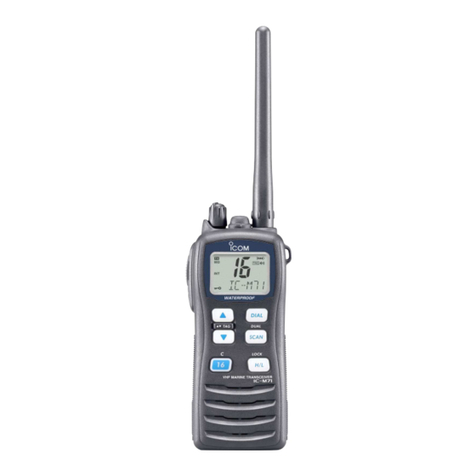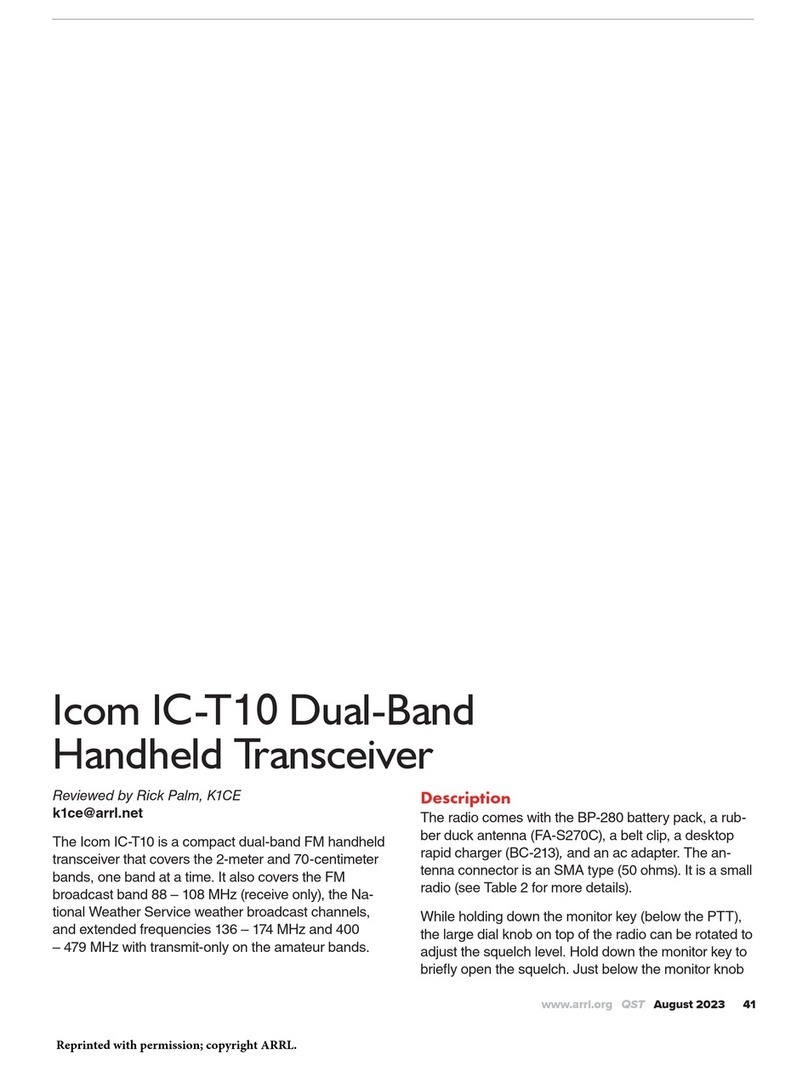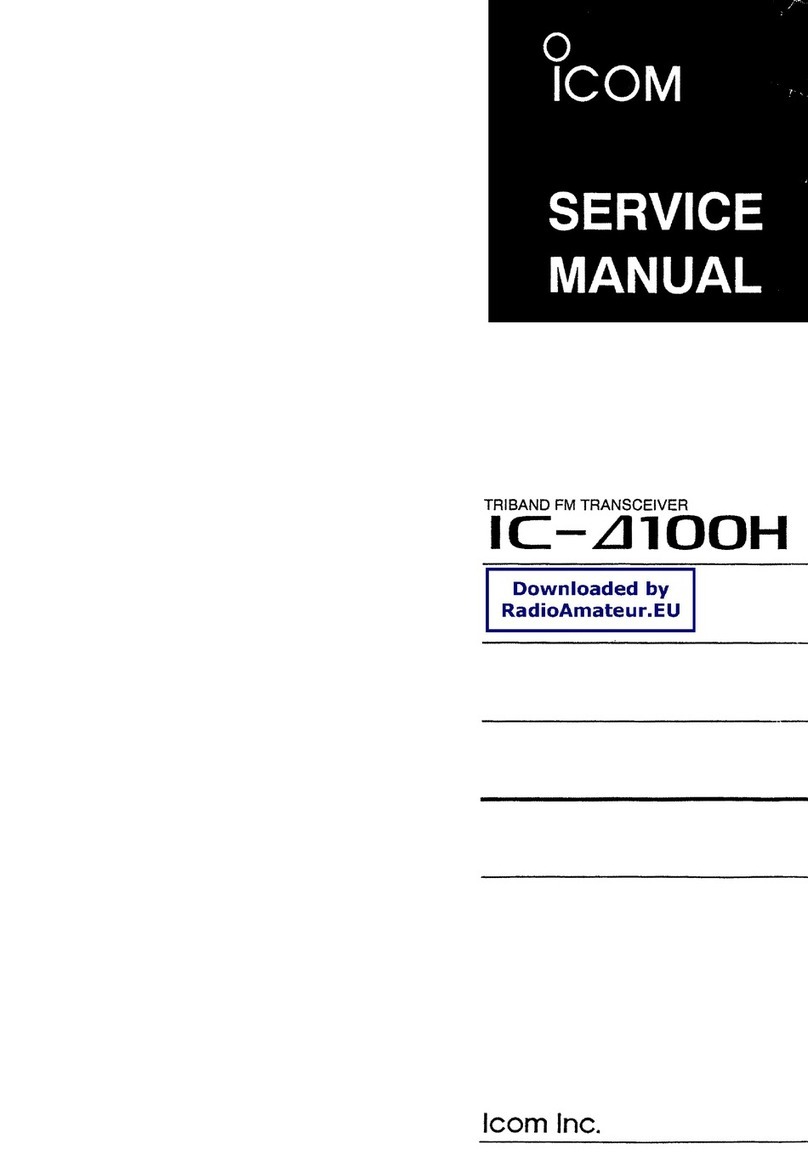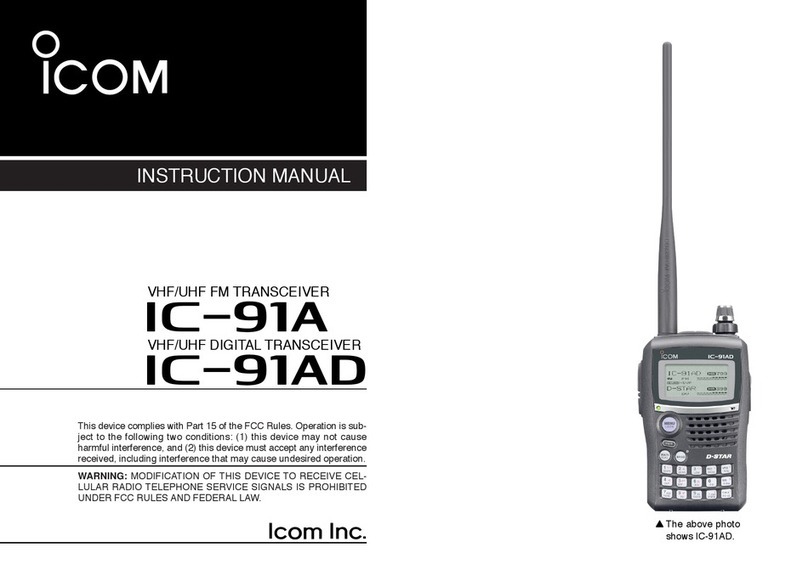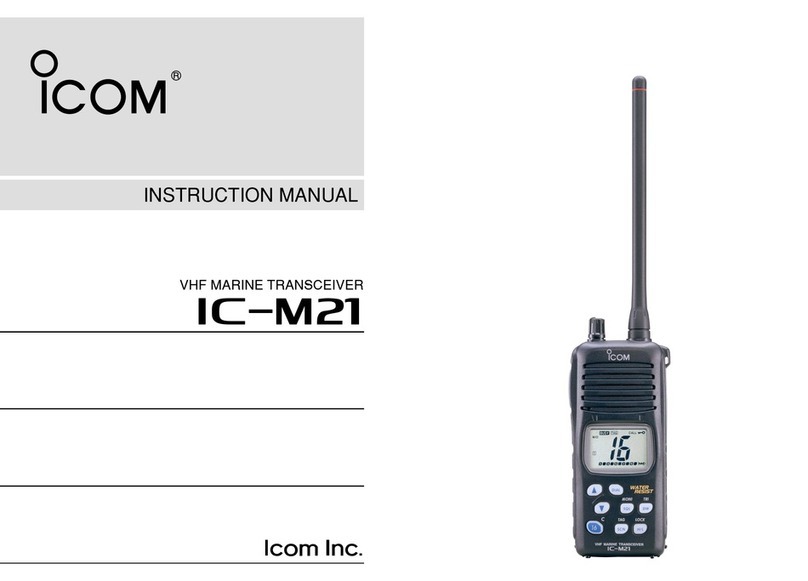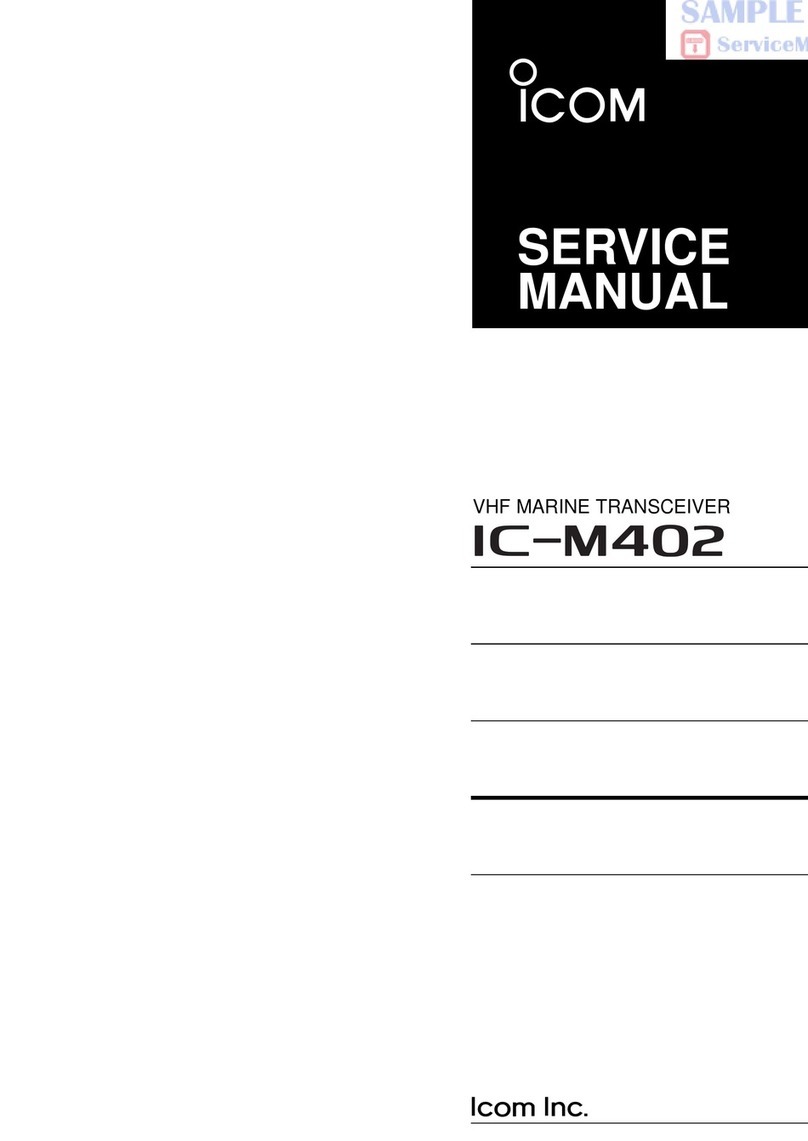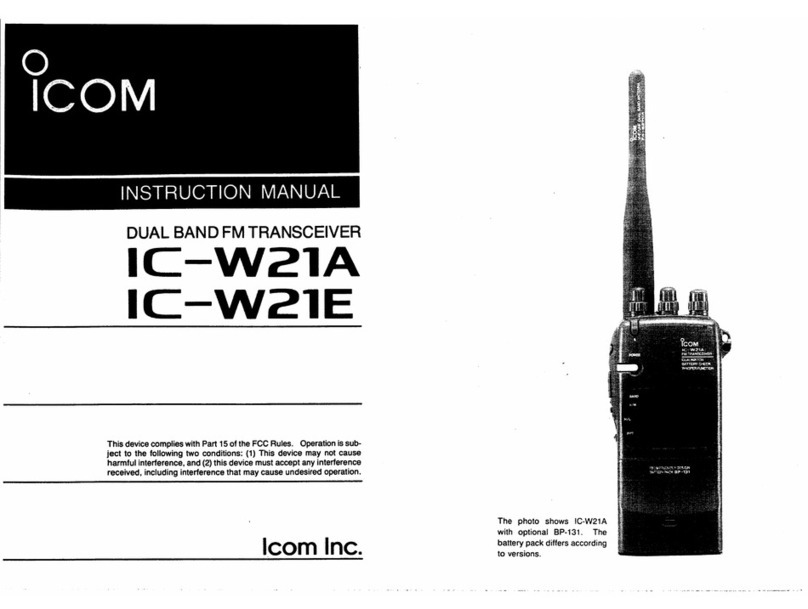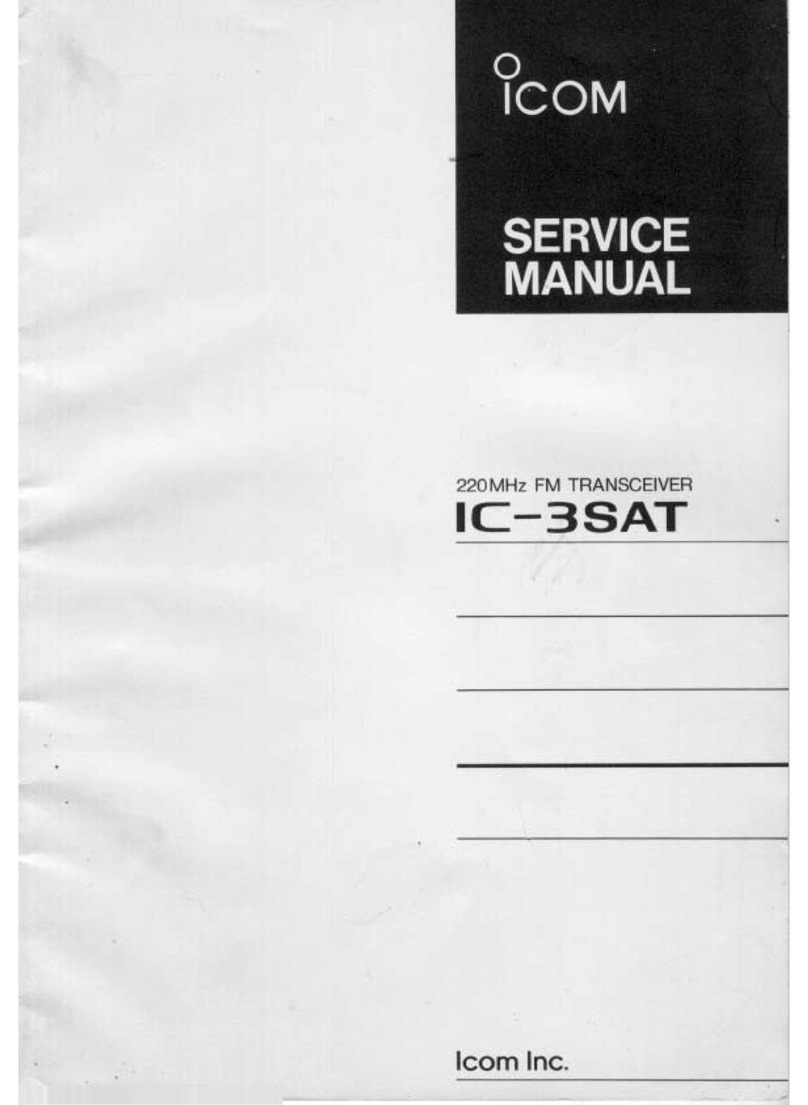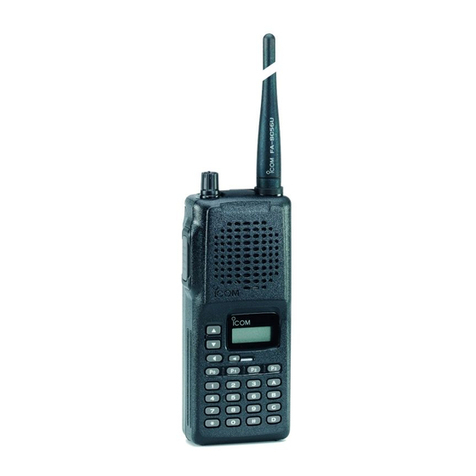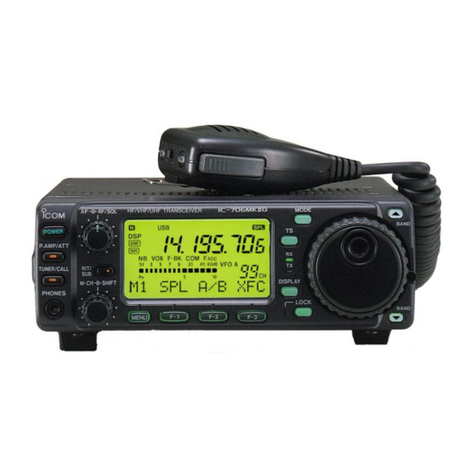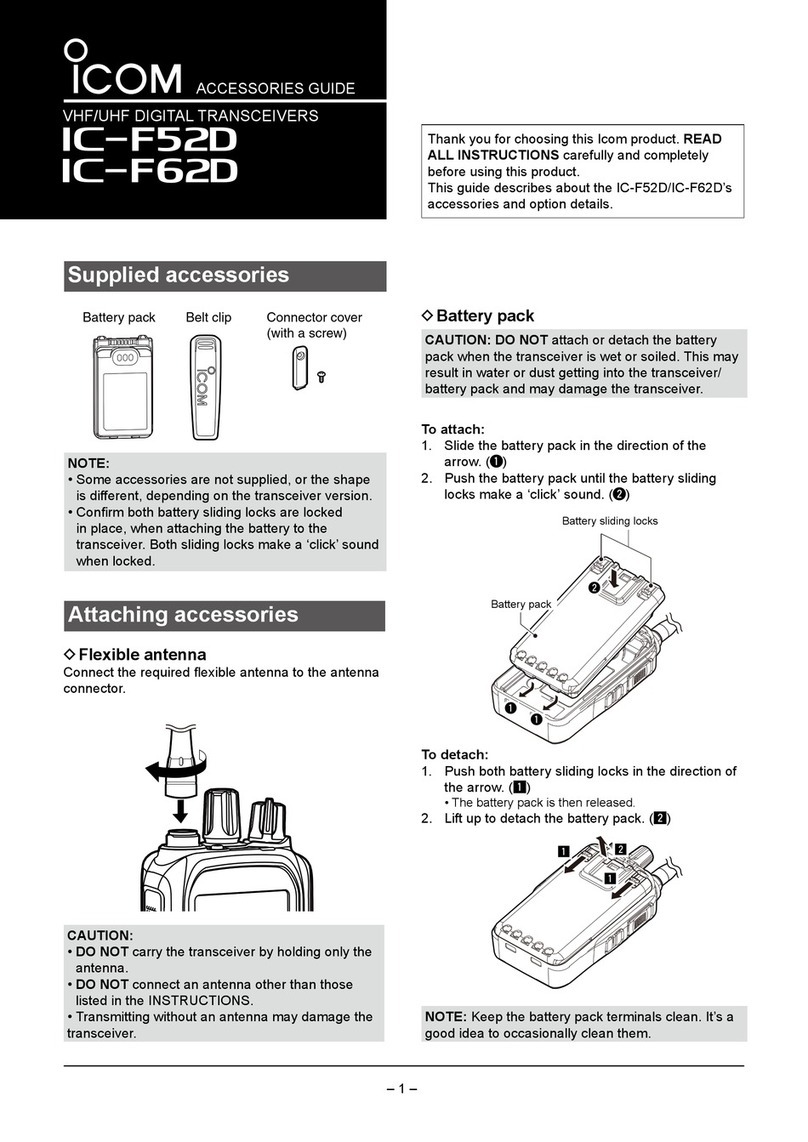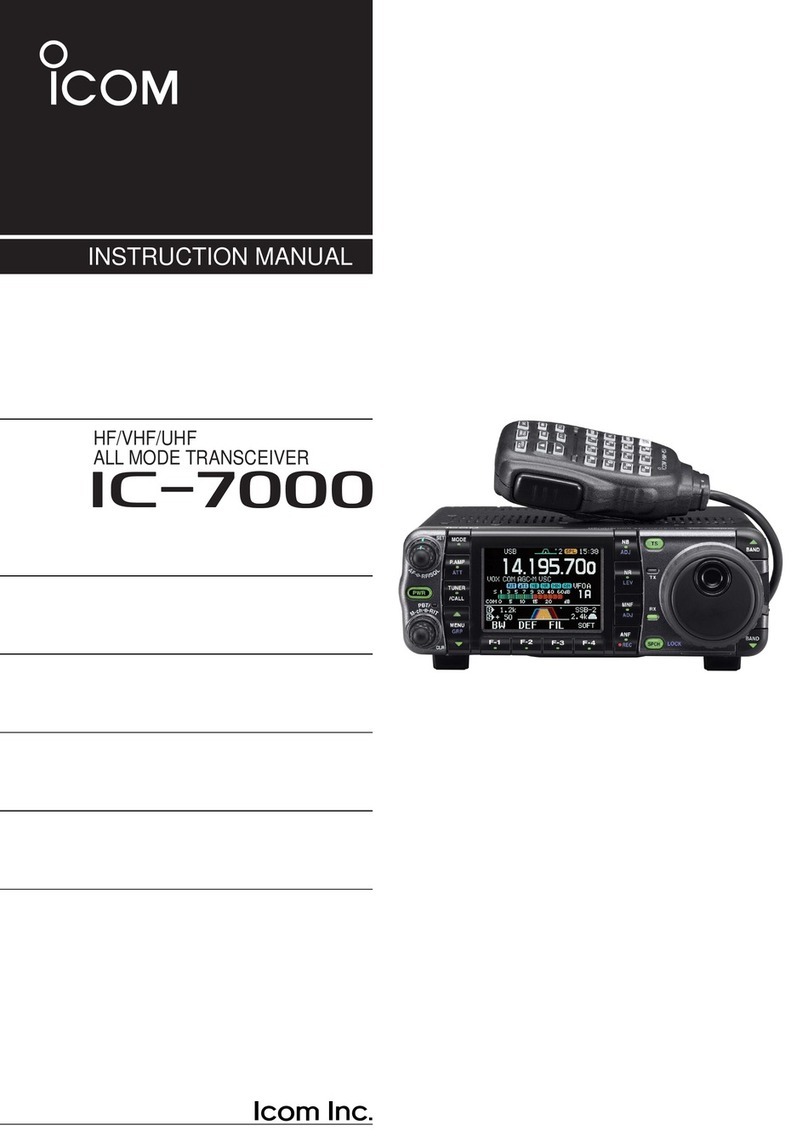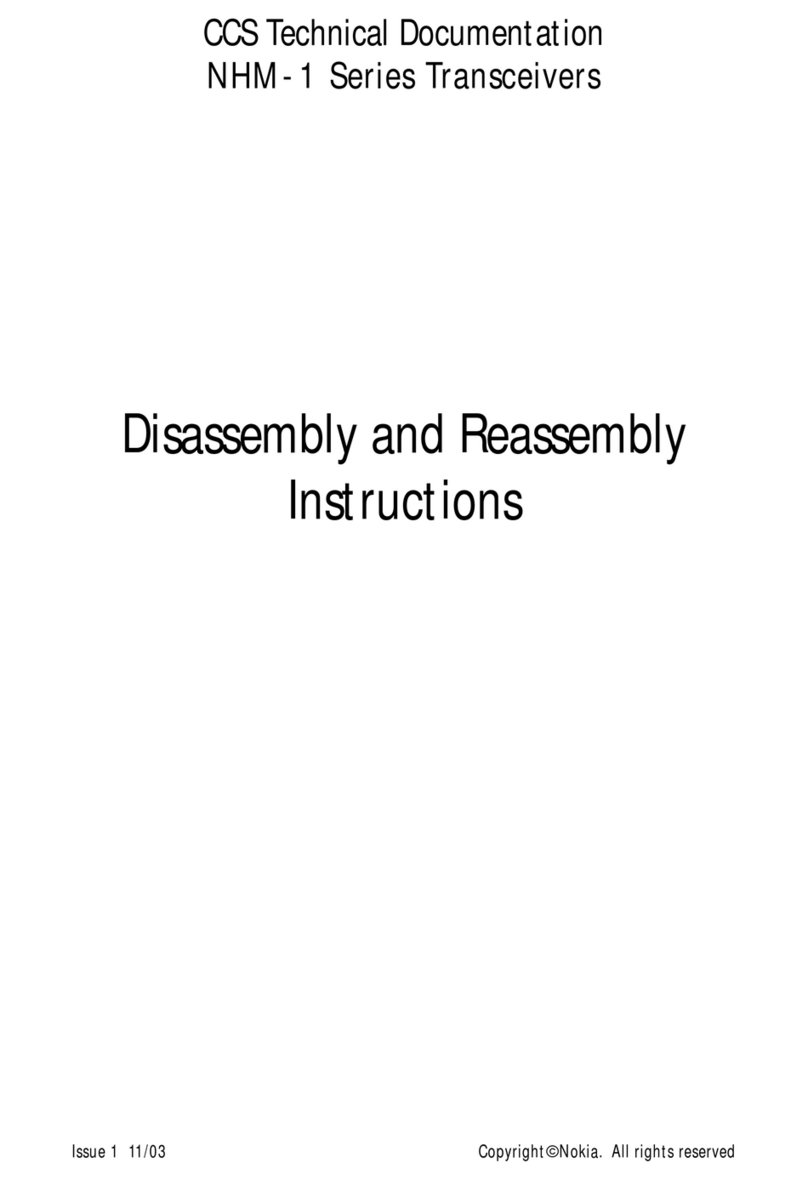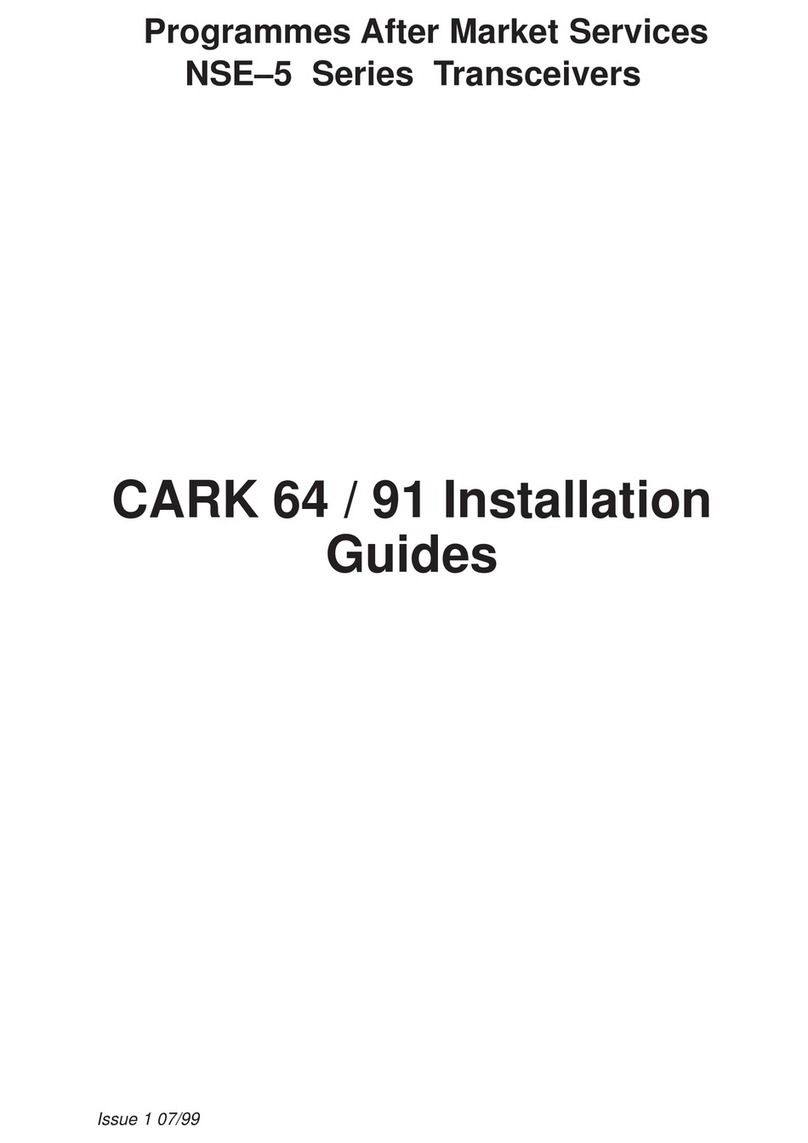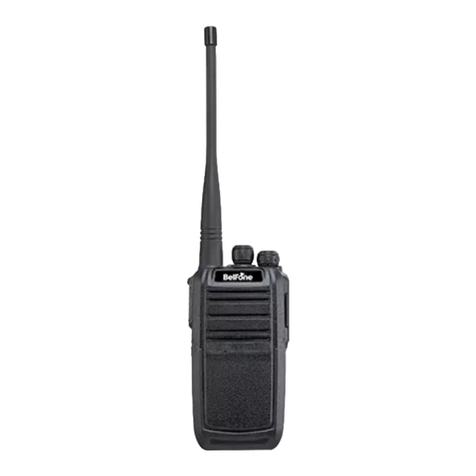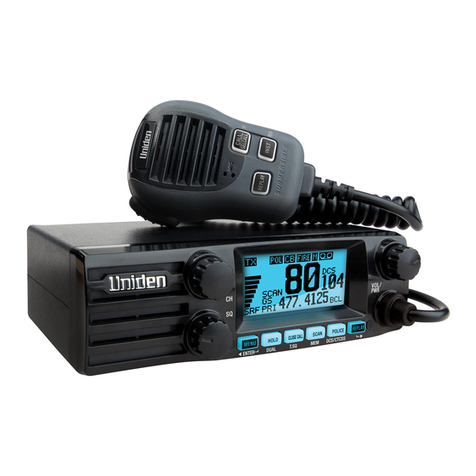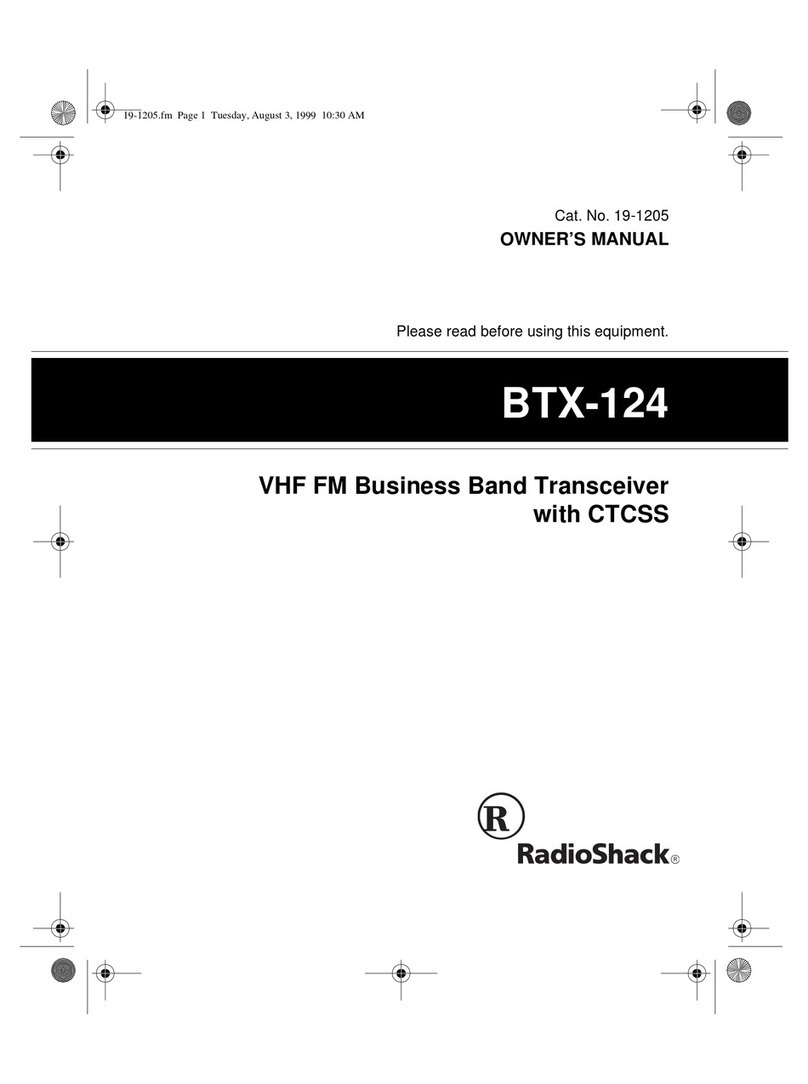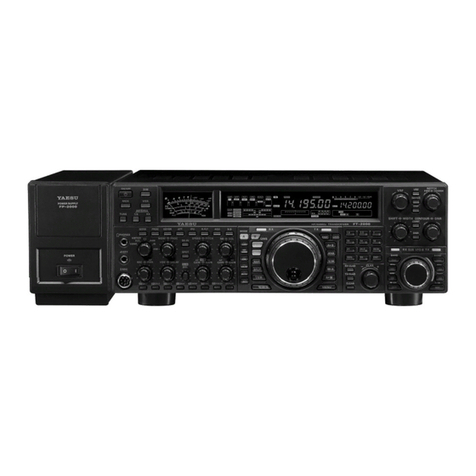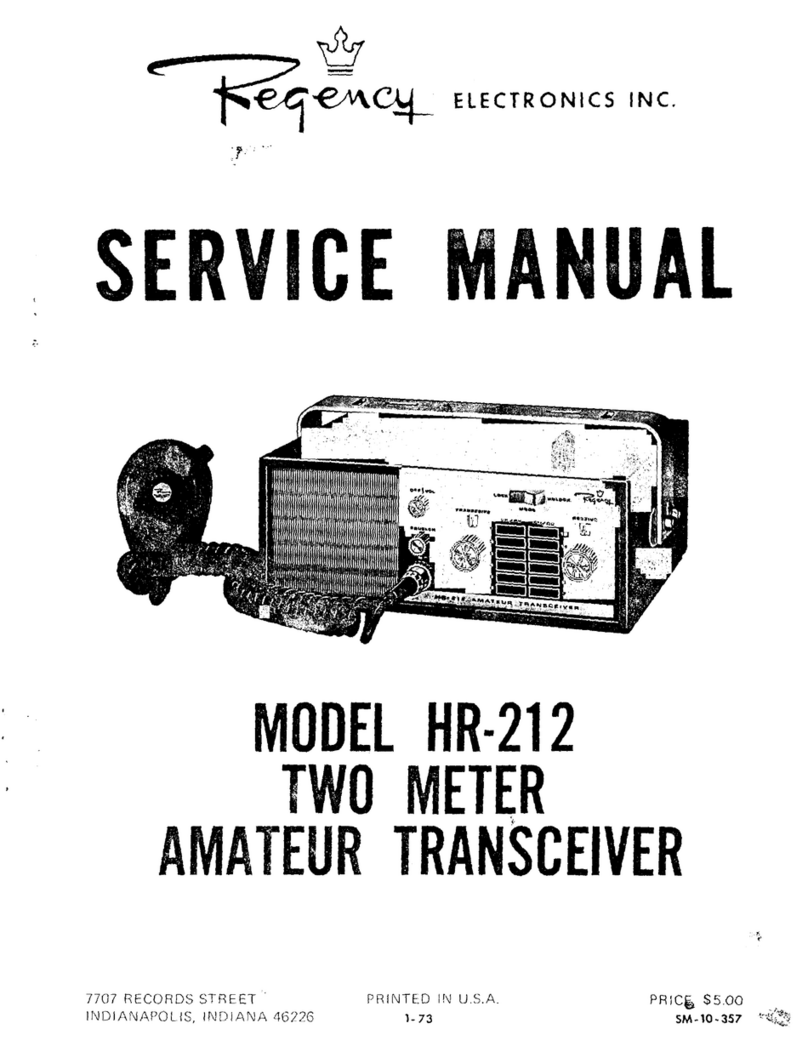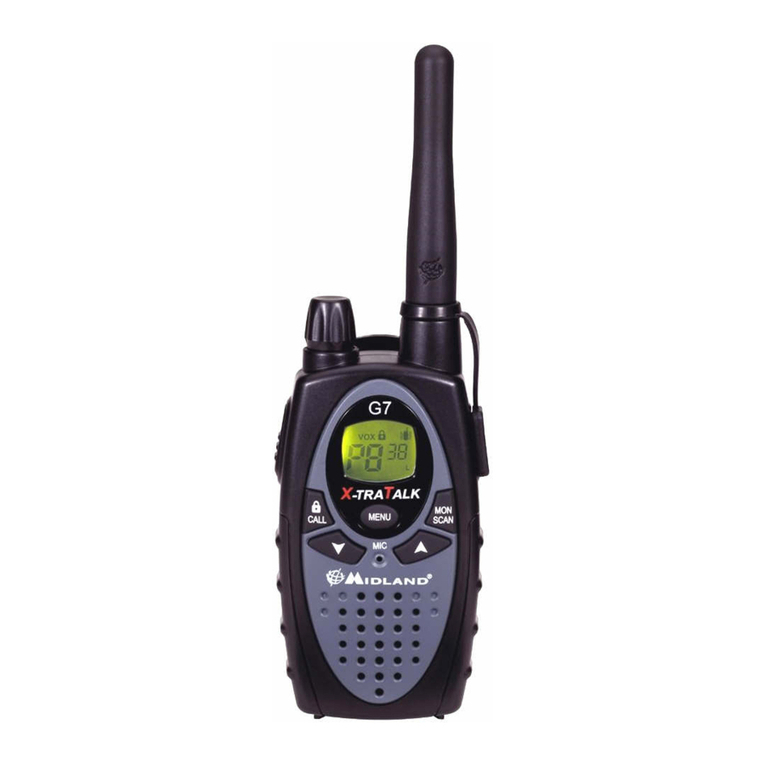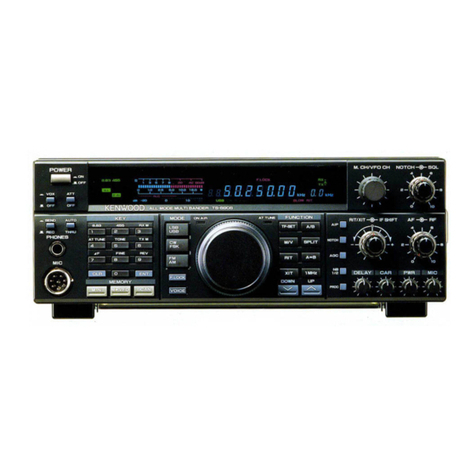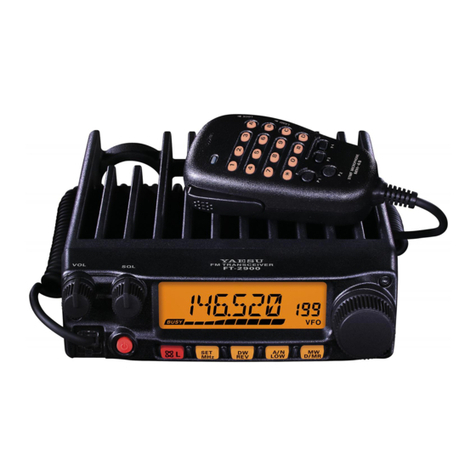Icom IC-M85UL User manual

VHF MARINE TRANSCEIVER
INSTRUCTION MANUAL
This device complies with Part 15 of the FCC
Rules. Operation is subject to the condition that
this device does not cause harmful interference.
iM85UL

IMPORTANT
READ ALL INSTRUCTIONS carefully and completely
before using the transceiver.
SAVE THIS INSTRUCTION MANUAL — This instruction
manual contains important operating instructions for the
IC-M85UL.
i
Thank you for choosing this Icom product.
This product is designed and built with Icom’s state of
the art technology and craftsmanship. With proper care,
this product should provide you with years of trouble-free
operation.
EXPLICIT DEFINITIONS
WORD DEFINITION
RDANGER! Personal death, serious injury or an explo-
sion may occur.
RWARNING! Personal injury, re hazard or electric
shock may occur.
CAUTION Equipment damage may occur.
NOTE
If disregarded, inconvenience only. No risk
of personal injury, re or electric shock.
IN CASE OF EMERGENCY
If your vessel requires assistance, contact other vessels and the
Coast Guard by sending a Distress call on Channel 16.
USING CHANNEL 16
DISTRESS CALL PROCEDURE
1. “MAYDAY MAYDAY MAYDAY.”
2. “THIS IS ...............” (name of vessel).
3. Say your call sign or other description of the vessel
(AND 9 digit DSC ID if you have one).
4. “LOCATED AT ...............” (your position).
5. State the nature of the distress and assistance required.
6. Give any other information which might facilitate the
rescue.
RECOMMENDATION
CLEAN THE TRANSCEIVER THOROUGHLY IN A BOWL OF
FRESH WATER after exposure to saltwater, and dry it before
operating. Otherwise, the transceiver’s keys, switches, and
controllers may become unusable, due to salt crystallization, and/or
the charging terminals of the battery pack may corrode.
NOTE: If the transceiver’s waterproof protection appears
defective, carefully clean the transceiver with a soft, damp (fresh
water) cloth, then dry it before operating. The transceiver may
lose its waterproof protection if the case, jack cap, or connector
cover is cracked or broken, or the transceiver has been dropped.
Contact your Icom distributor or your dealer for advice.

CAUTION: DO NOT expose the transceiver to rain, snow or
any liquids. The transceiver meets IP67 requirements for dust-
protection and splash resistance. However, once the transceiver
has been dropped, dust protection and splash resistance cannot be
guaranteed due to the fact that the transceiver may be cracked, or
the waterproof seal damaged, and so on.
DO NOT place or leave the transceiver in direct sunlight or in areas
outside of the specied temperature range:
Operating temperature range: –30°C (–22˚F) ~ +60°C (+140˚F)
Keep the transceiver in a secure place to prevent use by
unauthorized persons.
BE CAREFUL! Even if the volume level is set low, the beeps of the
Man Down, Lone Worker and MOB functions are very loud.
ii
R DANGER! NEVER short the terminals of the battery pack.
Shorting may occur if the terminals touch metal objects such
as a key, so be careful when placing the battery packs (or the
transceiver) in bags, and so on. Carry them so that shorting cannot
occur with metal objects. Shorting may damage not only the battery
pack, but also the transceiver.
R DANGER! NEVER use or charge Icom battery packs with non-
Icom transceivers or non-Icom chargers. Only Icom battery packs
are tested and approved for use with Icom transceivers or charged
with Icom chargers. Using third-party or counterfeit battery packs or
chargers may cause smoke, re, or cause the battery to burst.
R DANGER! NEVER operate the transceiver near unshielded
electrical blasting caps or in an explosive atmosphere.
R WARNING! NEVER hold the transceiver so that the antenna is
very close to, or touching exposed parts of the body, especially the
face or eyes, while transmitting. The transceiver will perform best if
the microphone is 5 to 10 cm (2 to 4 inches) away from the lips and
the transceiver is vertical.
R WARNING! NEVER operate the transceiver with a headset
or other audio accessories at high volume levels. The continuous
high volume operation may cause a ringing in your ears. If you
experience the ringing, reduce the volume level or discontinue use.
CAUTION: DO NOT use harsh solvents such as Benzine or alcohol
when cleaning. This could damage the equipment surfaces. If the
surface becomes dusty or dirty, wipe it clean with a soft, dry cloth.
CAUTION: DO NOT place or leave the transceiver in excessively
dusty environments. This could damage the transceiver.
PRECAUTIONS
Icom, Icom Inc. and Icom logo are registered trademarks of Icom Incorporated
(Japan) in Japan, the United States, the United Kingdom, Germany, France,
Spain, Russia, Australia, New Zealand, and/or other countries.
All other products or brands are registered trademarks or trademarks of their
respective holders.
Icom is not responsible for the destruction, damage to, or
performance of any Icom or non-Icom equipment, if the
malfunction is because of:
• Force majeure, including, but not limited to, res, earthquakes,
storms, oods, lightning, other natural disasters, disturbances,
riots, war, or radioactive contamination.
• The use of Icom transceivers with any equipment that is not
manufactured or approved by Icom.

iii
ATTENTION: NE PAS utiliser de dissolvants agressifs tels que du
Benzène ou de l'alcool lors du nettoyage, car ils endommageraient
les surfaces de l'émetteur-récepteur. Si l'émetteur-récepteur est
poussiéreux ou sale, nettoyez-le avec un tissu doux et sec.
ATTENTION: NE PAS placer l'émetteur-récepteur dans des
environnements excessivement poussiéreux. Cela pourrait
endommager l'émetteur-récepteur.
ATTENTION: NE PAS exposer l’émetteur-récepteur à la pluie,
à la neige ou à tout liquide. Cet émetteur-récepteur répond aux
exigences de la norme IP67 en matière de protection contre
la poussière et de résistance aux éclaboussures. Cependant,
en cas de chute de l'émetteur-récepteur, la protection contre la
poussière et la résistance aux éclaboussures ne peuvent plus être
garanties, car le boitier risque d'être ssuré ou le joint d'étanchéité
endommagé, etc.
NE PAS placer ou laisser l’émetteur-récepteur en plein soleil ou
dans un environnement soumis à des températures inférieures à
–30°C (–22˚F) ou supérieures à +60°C (+140˚F).
Placez l’émetteur-récepteur dans un lien sûr pour éviter toute
utilisation par des personnes non autorisées.
MISE EN GARDE! Même si le niveau de volume est bas, les bips
des fonctions Man Down, Lone Worker et MOB sont très forts.
PRÉCAUTIONS (pour le Canada)
RDANGER! NE JAMAIS court-circuiter les bornes du bloc-
batterie. Un court-circuit peut se produire si les bornes touchent des
objets métalliques, tels que des clés, faites donc attention lorsque
vous rangez des blocs-batteries (ou l’émetteur-récepteur) dans
des sacs, etc. Transportez-les de telle sorte que des courts-circuits
ne peuvent se produire avec des objets métalliques.Car cela peut
endommager le bloc-batterie ainsi que l'émetteur-récepteur.
RDANGER! N'utilisez JAMAIS et ne rechargez JAMAIS des blocs-
batteries Icom avec des émetteurs-récepteurs non-Icom ou des
chargeurs non-Icom. Seuls les blocs-batteries Icom sont testés et
homologués pour être utilisés avec des émetteurs-récepteurs Icom
ou pour être rechargés avec des chargeurs Icom. L'utilisation de
blocs-batteries ou de chargeurs tiers ou de contrefaçon peut être à
l'origine de fumées, d'incendie ou peut faire éclater la batterie.
RDANGER! NE JAMAIS utiliser l'émetteur-récepteur à proximité
de détonateurs électriques non blindés ou dans une atmosphère
explosive.
RAVERTISSEMENT! NE JAMAIS tenir le terminal de
communication avec l'antenne placée à proximité immédiate ou en
contact avec des parties du corps exposées, en particulier le visage
ou les yeux, lors des transmissions.Les performances de la radio
sont optimales quand le microphone est tenu entre 5 et 10 cm de la
bouche de l’utilisateur et quand l’appareil est vertical.
RAVERTISSEMENT! NE JAMAIS utiliser l'émetteur-récepteur
avec un casque ou tout autre accessoire audio à un niveau
sonore élevé. L’utilisation continue à un niveau sonore élevé peut
provoquer un bourdonnement dans vos oreilles.
Icom n'est pas responsable de la destruction ou des dommages sur
l'é metteur-récepteur Icom, si le dysfonctionnement est causé par:
• Force majeure, sans toutefois s'y limiter, les incendies,
tremblements de terre, tempêtes, inondations, la foudre, ou
autres catastrophes naturelles, perturbations, émeutes, guerre,
ou contamination radioactive.
• L'utilisation de l'émetteur-récepteur Icom avec tout équipement
non fabriqué ou approuvé par Icom.

vi
TABLE OF CONTENTS
IMPORTANT....................................................................................i
EXPLICIT DEFINITIONS.................................................................i
IN CASE OF EMERGENCY............................................................i
RECOMMENDATION......................................................................i
PRECAUTIONS...............................................................................ii
PRÉCAUTIONS (pour le Canada)...................................................iii
1 OPERATING RULES ...............................................................1
2 ACCESSORIES .......................................................................2
■Supplied accessories...........................................................2
■Attaching accessories..........................................................2
3 PANEL DESCRIPTION ............................................................5
■Front, top and side panels ...................................................5
■Function display...................................................................6
4 BATTERY CHARGING ............................................................7
■Battery caution.....................................................................7
■Charging caution..................................................................8
■Battery charger ...................................................................9
5 BASIC OPERATION ................................................................11
■Selecting a channel..............................................................11
■Receiving and transmitting...................................................13
■Adjusting the squelch level ..................................................14
■Using the VOX function........................................................14
■Using the AquaQuake water draining function.....................14
6 SCAN .......................................................................................15
■Scan types ...........................................................................15
■Favorite channels.................................................................16
■Starting a scan.....................................................................16
7 DUALWATCH/TRI-WATCH......................................................17
■Description...........................................................................17
■Operation .............................................................................17
8 OTHER FUNCTIONS...............................................................18
■Using the LAND channel group ...........................................18
■Using the Voice Scrambler ..................................................18
■Checking the battery health and battery cycle.....................18
9 SET MODE...............................................................................19
■Using the Set mode .............................................................19
■Set mode items....................................................................20
10 SPECIFICATIONS AND OPTIONS..........................................23
■Specications.......................................................................23
■Options.................................................................................24
■Using the HM-184UL............................................................25
11 VHF MARINE CHANNEL LIST................................................26
12 TROUBLESHOOTING.............................................................27
13 INFORMATION ........................................................................30
■UL information......................................................................30
■Firmware version identication ............................................31
■FCC information...................................................................31
■Information FCC...................................................................31
■Safety training information ...................................................32
■Infomation en matiére de sécurité........................................34

New2001
1
New2001
OPERATING RULES
1
DPriorities
• Read all rules and regulations pertaining to call priorities,
and keep an up-to-date copy handy. Safety and distress
calls take priority over all others.
• You must monitor Channel 16 when you are not operating
on another channel.
• False or fraudulent distress calls are prohibited under law.
DPrivacy
• Information overheard, but not intended for you, cannot
lawfully be used in any way.
• Indecent or profane language is prohibited.
DRadio licenses
(1) SHIP STATION LICENSE
You may require a current radio station license before using
the transceiver. It is unlawful to operate a ship station which
is not licensed, but required to be.
If required, contact your dealer or the appropriate
government agency for a Ship-Radiotelephone license
application. This government-issued license states the call
sign which is your craft’s identication for radio purposes.
(2) OPERATOR’S LICENSE
A Restricted Radiotelephone Operator Permit is the license
most often held by small vessel radio operators when a
radio is not required for safety purposes.
If required, the Restricted Radiotelephone Operator Permit
must be posted or kept with the operator. If required, only a
licensed radio operator may operate a transceiver.
However, non-licensed individuals may talk over a
transceiver if a licensed operator starts, supervises, ends
the call and makes the necessary log entries.
A current copy of the applicable government rules and
regulations is only required to be on hand for vessels in
which a radio telephone is compulsory. However, even
if you are not required to have these on hand it is your
responsibility to be thoroughly acquainted with all pertinent
rules and regulations.

2
2
ACCESSORIES
New2001
1
2
3
4
5
6
7
8
9
10
11
12
13
14
15
16
■Supplied accessories ■Attaching accessories
DFlexible antenna
Connect the supplied exible antenna to the antenna
connector.
CAUTION:
•DO NOT carry the transceiver by holding only the antenna.
• DO NOT connect an antenna other than those listed in
this instruction manual.
NOTE: Some accessories are not supplied, or the shape is
different, depending on the transceiver version.
Antenna
Belt clip
Power adapter
(For Battery charger)
Handstrap
Battery charger
(With a screw)
Battery pack

3
2ACCESSORIES
New2001
DBattery pack
To attach:
1. Slide the battery pack in the direction of the arrow. (q)
2. Push the battery pack until the battery sliding locks
make a ‘click’ sound. (w)
To detach:
1. Pull both battery sliding locks in the direction of the
arrow. (z)
2. Lift up to detach the battery pack. (x)
Battery sliding locks
Battery pack
CAUTION: DO NOT attach or detach the battery pack
when the transceiver is wet or soiled. This may result in
water or dust getting into the transceiver/ battery pack and
may damage the transceiver.
NOTE: Keep the battery pack terminals clean. It’s a good
idea to occasionally clean them.
x
q
q
w
z
z

DBelt clip
To attach:
1. Remove the battery pack from the transceiver, if it is
attached.
2. Slide the belt clip in the direction of the arrow until the
belt clip is locked and makes a ‘click’ sound.
4
2
ACCESSORIES
New2001
1
2
3
4
5
6
7
8
9
10
11
12
13
14
15
16
To detach:
Lift the tab up (q), and slide the belt clip in the direction of
the arrow (w).
Belt clip
q
w
BE CAREFUL! DO NOT break your ngernail.

5
New2001New2001
PANEL DESCRIPTION
3
■Front, top and side panels
qLOCK KEY [ ]
Hold down for 1 second to lock or unlock the keypad.
LPush to use the pre-assigned function. Ask dealer for details.
w PTT SWITCH [PTT]
Hold down to transmit, release to receive.
e CHANNEL 16/CALL CHANNEL KEY [16/C] (p. 11)
zPush to select Channel 16.
zHold down for 1 second to select the Call channel.
r SQUELCH ADJUSTMENT KEY [SQL] (p. 14)
zPush to enter or exit the Squelch Adjustment mode.
zHold down to open the squelch, to monitor the channel.
t TRANSMIT POWER KEY [H/L]
zPush to set the power level to high, mid, or low.
LSome channels are set to only low power.
zHold down for 1 second to display the battery health
and battery cycle. (p. 18)
y FAVORITE CHANNEL KEY [FAV] (p. 16)
zPush to select a Favorite channel.
zHold down for 1 second to set or clear the selected
channel as a Favorite channel.
u SCAN/DUALWATCH KEY [SCAN]/[DUAL]
zPush to start or stop a scan. (p. 15)
zHold down for 1 second to start the Dualwatch.* (p. 17)
LWhile Dualwatch, push to cancel Dualwatch.
*Tri-watch may start, depending on the Set mode settings.
i WEATHER CHANNEL/CHANNEL GROUP KEY
[CH/WX]/[U/I/C/L]
z Push to enter or exit the Weather Channel Selection
mode. (p. 12)
zHold down for 1 second to change the channel group. (p. 12)
o MULTI-CONNECTOR
Connects to an optional speaker microphone or headset.
!0 STATUS INDICATOR
zLights red while transmitting.
zLights green while receiving a signal, or when the
squelch is open.
!1 VOLUME/POWER SWITCH [VOL]
zRotate to turn the transceiver ON or OFF.
z Rotate to adjust the audio output level.
!2 TUNING DIAL [DIAL]
zRotate to select a channel.
!2
Antenna
Connector
q
w
y
e
r
t
Speaker
i
u
!1
Microphone
o
!0

6
3
PANEL DESCRIPTION
New2001
1
2
3
4
5
6
7
8
9
10
11
12
13
14
15
16
New2001
■Function display
TRANSMIT POWER INDICATOR “MID”/“LOW”
Displayed when low power or mid power is selected.
VOX INDICATOR “VOX”
Displayed when the VOX function* is ON.
*Usable only when the optional PTT switch cable and headset are
connected.
VOICE SCRAMBLER INDICATOR “SCRM”
Displayed when the Voice scrambler is ON. (p. 18)
MAN DOWN ICON “ ”
Displayed when the Man Down Alarm function is ON. (p. 22)
LONE WORKER ICON “ ”
Displayed when the Lone Worker Alarm function is ON. (p. 22)
BATTERY INDICATOR “ ”
Displays the battery status.
Battery
status Full Mid Charging
required
Battery
exhausted
Indication
FAVORITE CHANNEL ICON “ ”
Displayed when a Favorite channel is selected. (p. 16)
SCAN INDICATOR “SCAN”
Blinks while scanning. (p. 15)
CALL CHANNEL INDICATOR “CALL”
Displayed when the Call channel is selected. (p. 11)
DUALWATCH/TRI-WATCH INDICATOR “DUAL”/“TRI”
Displayed during Dualwatch or Tri-watch operation. (p. 17)
DUPLEX INDICATOR “DUP”
Displayed when a Duplex channel is selected.
LOCK ICON “ ”
Displayed when the Lock function is ON.
CHANNEL GROUP INDICATOR “INT”/“USA”/“CAN”/“LAND”
Displays the selected channel group.*1 (p. 12)
*1 The selectable channel groups may differ, depending on the
version.
WEATHER CHANNEL ICON “ ”
Displayed when the Weather channel is selected. (p. 12)
L“ ” is displayed when the Weather Alert function is ON.

New2001
7
New2001New2001
BATTERY CHARGING
4
■Battery caution
RDANGER! NEVER solder the battery terminals, or NEVER
modify the battery pack. This may cause heat generation, and
the battery may burst, emit smoke or catch re.
RDANGER! NEVER place or leave battery packs in areas
with temperatures above 60°C (140°F). High temperature
buildup in the battery cells, such as could occur near res or
stoves, inside a sun-heated vehicle, or in direct sunlight for
long periods of time may cause the battery cells to rupture
or catch re. Excessive temperatures may also degrade the
battery pack’s performance or shorten the battery cell’s life.
RDANGER! NEVER strike or otherwise impact the battery
pack. Do not use the battery pack if it has been severely
impacted or dropped, or if the pack has been subjected to
heavy pressure. Battery pack damage may not be visible
on the outside of the case. Even if the surface of the battery
does not show cracks or any other damage, the cells inside
the battery may rupture or catch re.
RDANGER! NEVER expose the battery pack to rain, snow,
seawater, or any other liquids. Do not charge or use a wet
pack. If the pack gets wet, be sure to wipe it dry before using.
RDANGER! NEVER place or leave battery packs near re.
Fire or heat may cause them to rupture or explode. Dispose
of used battery packs in accordance with local regulations.
RDANGER! NEVER let uid from inside the battery get in
your eyes. This can cause blindness. Rinse your eyes with
clean water, without rubbing them, and immediately go to a
doctor.
RWARNING! NEVER put the battery pack in a microwave
oven, high-pressure container, or in an induction heating
cooker. This could cause a re, overheating, or cause the
battery cells to rupture.
RWARNING! NEVER use the battery pack if it emits an
abnormal odor, heats up, or is discolored or deformed. If
any of these conditions occur, contact your Icom dealer or
distributor.
RWARNING! NEVER Iet uid from inside the battery cells
come in contact with your body. If it does, immediately wash
with clean water.
CAUTION: DO NOT use the battery pack out of the
specied temperature range for the transceiver (–30°C
~ +60°C (–22°F ~ +140°F)) and the battery itself (–20°C
~ +60°C (–4°F ~ +140°F)). Using the battery out of its
specied temperature range will reduce its performance and
battery cell’s life. Please note that the specied temperature
range of the battery may exceed that of the transceiver. In
such cases, the transceiver may not work properly because
it is out of its operating temperature range.
Misuse of Li-ion batteries may result in the following
hazards: smoke, re, or the battery may rupture. Misuse
can also cause damage to the battery or degradation of
battery performance.

New2001
8
4
BATTERY CHARGING
New2001
1
2
3
4
5
6
7
8
9
10
11
12
13
14
15
16
New2001
CAUTION: DO NOT leave the pack fully charged,
completely discharged, or in an excessive temperature
environment (above 50°C, 122°F) for an extended period of
time. If the battery pack must be left unused for a long time,
it must be detached from the transceiver after discharging.
You may use the battery pack until the remaining capacity is
about half, then keep it safely in a cool and dry place at the
following temperature range:
–20°C ~ +50°C (–4°F ~ +122°F) (within a month)
–20°C ~ +40°C (–4°F ~ +104°F) (within three months)
–20°C ~ +20°C (–4°F ~ +68°F) (within a year)
BE SURE to replace the battery pack with a new one
approximately ve years after manufacturing, even if it still
holds a charge. The material inside the battery cells will
become weak after a period of time, even with little use.
The estimated number of times you can charge the pack
is between 300 and 500. Even when the pack appears to
be fully charged, the operating time of the transceiver may
become short when:
• Approximately 5 years have passed since the pack was
manufactured.
• The pack has been repeatedly charged.
■Charging caution
RDANGER! NEVER charge the battery pack in areas with
extremely high temperatures, such as near res or stoves,
inside a sun-heated vehicle, or in direct sunlight. In such
environments, the safety/protection circuit in the battery will
activate, causing the battery to stop charging.
RWARNING! NEVER charge the transceiver during a
lightning storm. It may result in an electric shock, cause a
re or damage the transceiver. Always disconnect the power
adapter before a storm.
RWARNING! NEVER charge or leave the battery in the
battery charger beyond the specied time for charging. If the
battery is not completely charged by the specied time, stop
charging and remove the battery from the battery charger.
Continuing to charge the battery beyond the specied time
limit may cause a re, overheating, or the battery may
rupture.
RWARNING! NEVER insert the transceiver (battery
attached to the transceiver) into the charger if it is wet or
soiled. This could corrode the battery charger terminals or
damage the charger. The charger is not waterproof.
CAUTION: DO NOT charge the battery outside of the
specied temperature range: BC-227 (15˚C ~ 40˚C
(59˚F ~ 104˚F)). Otherwise, the charging time will be longer,
but the battery will not reach a full charge. While charging,
at a point after the temperature goes out of the specied
range, the charging will automatically stop.

9
4BATTERY CHARGING
New2001
■Battery charger
DSupplied battery charger
Charging time: approximately 2.7 hours
DOptional BC-226 desktop charger
Charging time: approximately 2.7 hours
Battery pack
Power adapter*
* May not be supplied, or the shape may be different, depending on
the transceiver version.
Battery
charger
Status indicator
Turn OFF
LTo connect the power adapter to the charger, remove the
charger’s left cover.
Turn OFF
BC-226
Power
adapter*
Battery pack
Status
indicator

10
4
BATTERY CHARGING
New2001
1
2
3
4
5
6
7
8
9
10
11
12
13
14
15
16
Connecting BC-226 together
You can connect up to 6 BC-226 together.
1. Remove the charger’s right cover. (q)
2. Snap the DC power plug to the other charger’s DC
power jack. (w)
WARNING: DO NOT connect more than 6 chargers
together. It may result in an electric shock, cause a re,
overheating, or damage chargers.
DInformation
Status indicator
Light color Status
Orange Charging
Green Charging is completed.
Blinks orange and green Charging failed. It may have some
problems.
BC-226 Fuse replacement
If a fuse blows, nd and repair the cause of the problem.
Then replace the damaged fuse with a new, adequately
rated fuse.
Fuse type: 5 A/58 V (low prole mini blade fuse)
NOTE:
• The transceiver MUST be turned OFF while charging.
Otherwise:
- The battery will not be charged correctly.
- The battery life may be shortened.
• Do not transmit while charging. When you need to
transmit, remove the transceiver from the charger, and
then turn ON the power.
• If the battery pack does not properly charge when it is
attached to the transceiver, remove it from the transceiver
and insert only the battery pack into the charger.
NOTE: Remove the fuse using the needle-nose pliers.
Fuse

11
New2001New2001
BASIC OPERATION
5
■Selecting a channel
DChannel 16
Channel 16 is the distress and safety channel. It is used for
establishing initial contact with a station, and for emergency
communications.
While standing by, you must monitor Channel 16.
zPush [16/C] to select
Channel 16.
DCall channel
Each Channel Group has separate Call channels. The Call
channel is monitored during Tri-watch. The Call channels
can be selected and used to store your most often used
channel in each Channel Group, for quick recall.
zHold down [16/C] for 1
second to select the Call
channel.
• The Call channel number and
“CALL” are displayed.
LTo return to the previously
selected channel, push [CH/WX].
Setting the Call channel
By default, a Call channel is set in each Channel Group.
You can set your most often-used channel as your Call
channel in each Channel Group for a quick recall.
1. Hold down [16/C] for 1 second to select the Call
channel.
• “CALL” and Call channel number is displayed.
2. Hold down [16/C] again
for 3 seconds (until a
long beep changes to
2 short beeps) .
• The Call channel number
blinks.
3. Rotate [DIAL] to select
the channel.
4. Push [16/C] to set the selected channel as the Call
channel.
• The Call channel number stops blinking.

12
5
BASIC OPERATION
New2001
1
2
3
4
5
6
7
8
9
10
11
12
13
14
15
16
New2001
DChanging channel group
Channel Groups are preset into your transceiver. You can
select the Channel Group between USA, International, and
Canadian.
zHold down [U/I/C/L] for 1 second to change the channel
group.
DWeather channels
The transceiver has 10 preset Weather channels. You can
use these channels to monitor broadcasts from the National
Oceanographic and Atmospheric Administration (NOAA).
The transceiver automatically detects a Weather Alert tone
on the selected Weather channel, or while scanning.
1. Push [CH/WX] or to enter the Weather channel
selection mode.
2. Rotate [DIAL] to select a Weather channel.
Setting the Weather Alert
1. Turn OFF the transceiver.
2. While holding down [SQL], Turn ON the transceiver to
enter the Set mode.
3. Push [SQL] to select the Weather Alert item.
• “ ” is displayed.
4. Rotate [DIAL] to turn
ON the Weather Alert.
• “ ” is displayed.
5. Push [16/C] to exit the
Set mode.
Weather channel list
Channel Frequency
(MHz)
Channel Frequency (MHz)
1 162.550 6 162.500
2 162.400 7 162.525
3 162.475 8 161.650
4 162.425 9 161.775
5 162.450 10 163.275

13
5BASIC OPERATION
New2001
■Receiving and transmitting
1. Rotate [DIAL] to select a channel.
• When a signal is received, the status indicator lights green.
2. Hold down [PTT], and speak into the microphone to
transmit.
• The status indicator lights red while transmitting.
3. Release [PTT] to receive.
1. Select a channel.
2. Push to transmit.
3. Release to receive.
CAUTION: Transmitting without an antenna will damage
the transceiver.
NOTE: Before using the transceiver for the rst time, the
battery pack must be fully charged for optimum life and
operation. See Section 4 for battery charging.
NOTE:
• To conserve battery power, the Power Save function
automatically turns ON when no signal is received for 5
seconds.
• The Time-out Timer function cuts OFF transmission
after 5 minutes* of continuously transmitting, to prevent
prolonged transmission.
10 seconds before transmission is cut off, a beep sounds
to indicate the transmission will be cut off, and “TOT”
blinks. After it is cut OFF, “TOT” is displayed for 10
seconds, and you cannot transmit until it disappears.
TIP: To maximize the readability of your transmitted signal,
pause for a second after pushing [PTT] and hold the
microphone 5 to 10 cm (2 to 4 inches) from your mouth,
and then speak at your normal voice level.

14
5
BASIC OPERATION
New2001
1
2
3
4
5
6
7
8
9
10
11
12
13
14
15
16
■Adjusting the squelch level
The squelch enables the audio to be heard only while
receiving a signal that is stronger than the set level. A higher
level blocks weak signals, so that you can receive only
stronger signals. A lower level enables you to hear weak
signals.
1. Push [SQL] to enter the
Squelch Adjustment
mode.
2. Rotate [DIAL] to adjust the squelch level, until the noise
just disappears.
3. Push [16/C] to exit the Squelch Adjustment mode.
■Using the VOX function
The VOX function automatically switches between receive
and transmit by detecting your voice.
zWhile holding down [SQL], push [CH/WX] to turn ON or
OFF the function.
• “VOX” is displayed.
Water in the speaker grill may mufe the sound coming
from the speaker. The AquaQuake Water Draining function
removes water from the speaker grill by vibrating the
speaker cone.
LThe AquaQuake Water Draining function is not usable when
using an optional speaker microphone.
1. While holding down [H/L], push [FAV] to turn ON the
function.
• “ ” is displayed.
• A low frequency vibration beep sounds for 10 seconds to
drain the water, regardless of the volume level setting.
2. Push any key to turn OFF the function.
NOTE: The optional PTT switch cable and headset are
required to use the function.
■Using the AquaQuake water
draining function
TIP: When the AquaQuake Action setting is ON in the
Set mode, you can use the function by just shaking the
transceiver within 30 seconds, after the water is detected
(p. 22)

15
New2001New2001
SCAN
6
NORMAL SCAN
The Normal Scan sequentially searches through all
Favorite channels. However, Channel 16 is not checked
unless it is set as a Favorite channel.
PRIORITY SCAN
A Priority scan sequentially scans all Favorite channels
while monitoring Channel 16.
WX*
CH 01
CH 16
CH 02
CH 05 CH 04
CH 03
When a signal is received:
• On Channel 16
The scan pauses until the signal on Channel 16 disappears.
• On a channel other than Channel 16:
The scan switches to Dualwatch, until the signal disappears.
■Scan types
You can nd ongoing calls by scanning the Favorite channels.
Before starting a scan, you need to:
• Set the channels that you want to scan as Favorite
channels.
LOnly the Favorite channels are scanned.
• Turn ON the Priority Scan in the Set mode to use the
Priority Scan (p. 20).
*When the Weather Alert function is ON, the previously selected
Weather channel is also scanned.
CH 01 CH 02
WX*
CH 05 CH 04
CH 03
Table of contents
Other Icom Transceiver manuals
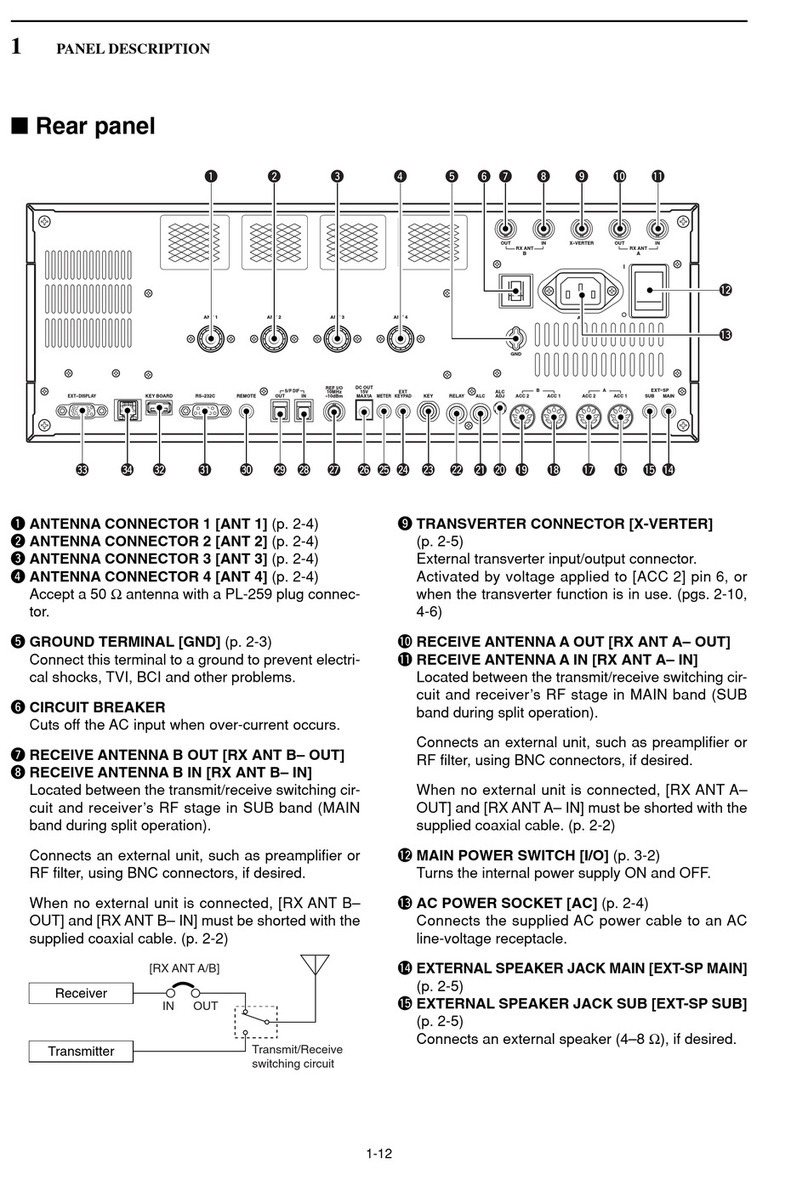
Icom
Icom IC-7800 User manual
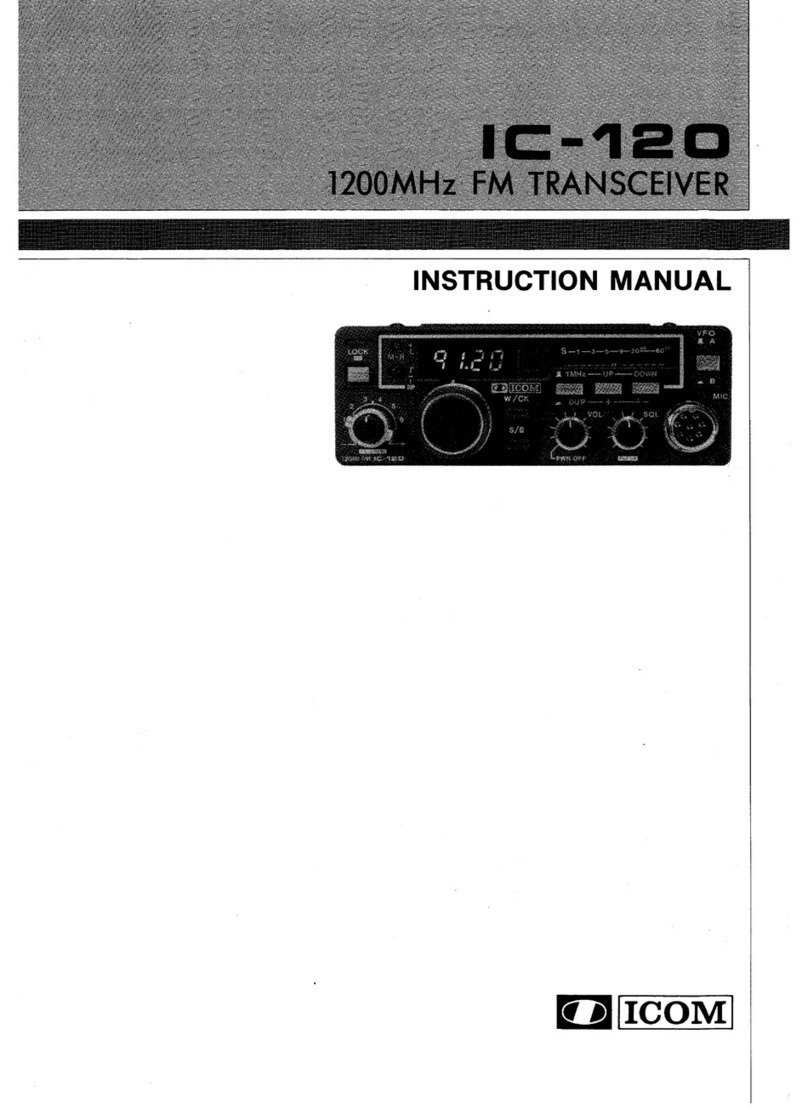
Icom
Icom IC-120 User manual

Icom
Icom IC-F5020 Series User manual
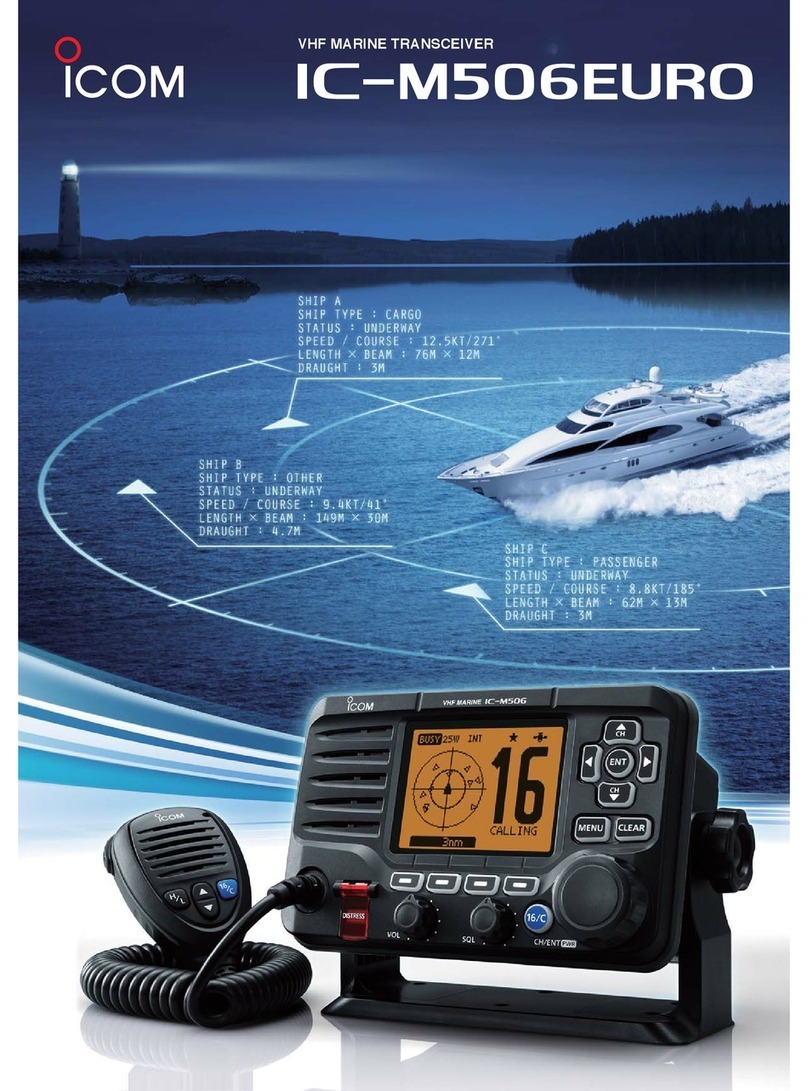
Icom
Icom IC-M506EURO User manual

Icom
Icom IC-7000 User manual
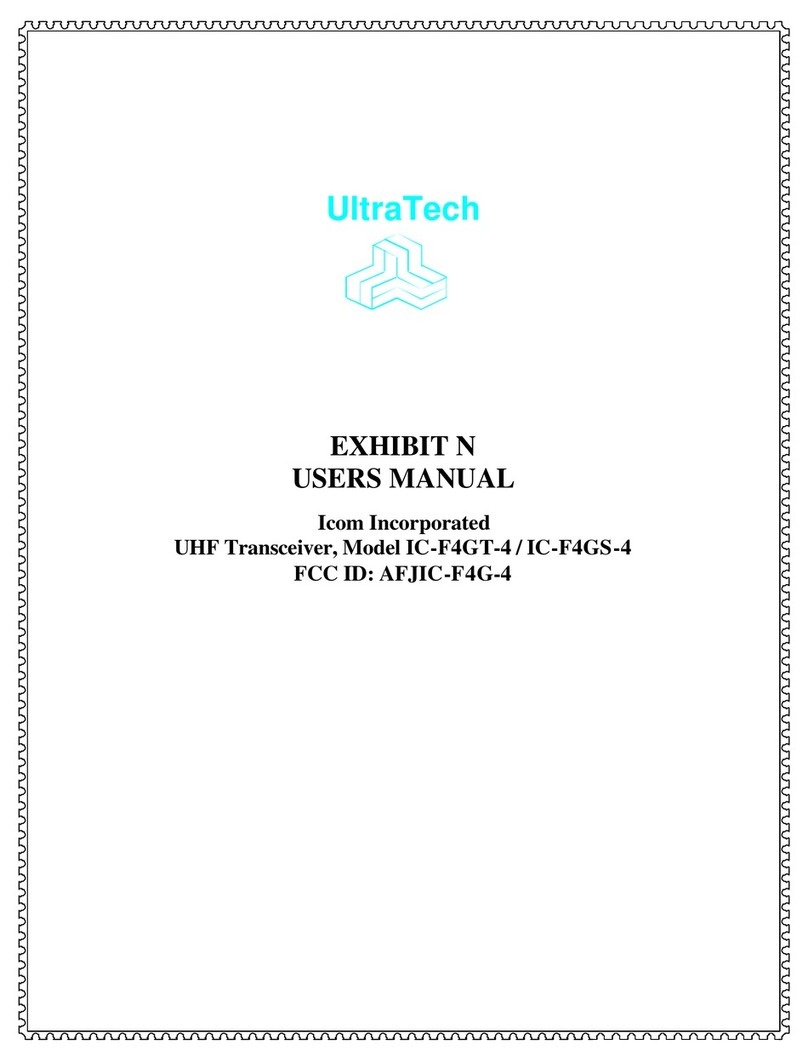
Icom
Icom UltraTech IC-F4GT-4 User manual
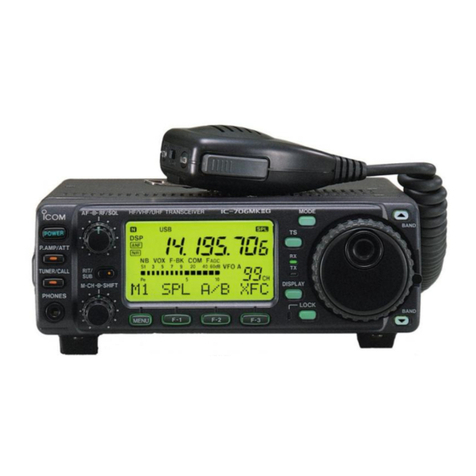
Icom
Icom IC-706MKIIG User manual
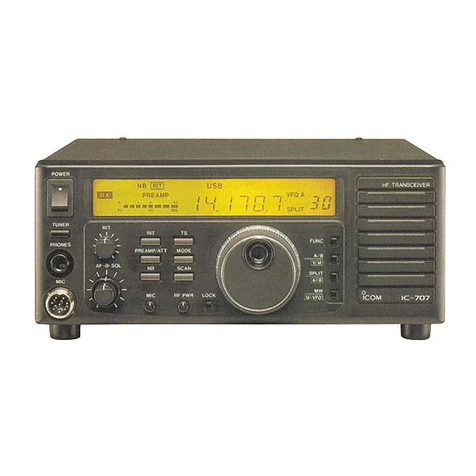
Icom
Icom IC-707 User manual
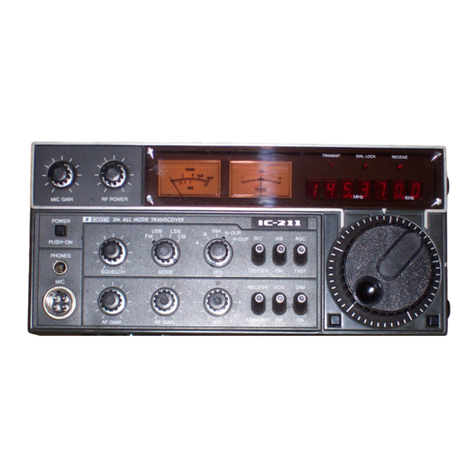
Icom
Icom IC-211E User manual

Icom
Icom IC-2iA User manual
